Brown trout are carnivorous by nature, and fly fishing with streamers that simulate baitfish will yield some excellent results.
Streamer fishing is typically the domain of the Stillwater angler in the United Kingdom. Streamers, on the other hand, can deliver fantastic results on rivers in the appropriate conditions.
Streamer fly fishing on rivers is not for everyone, and it does not replace classic fly fishing techniques such as dry fly fishing, wet fly fishing, nymphing, and so on.
I’ve caught some gorgeous brown trout on rivers when casting streamers, but my first choice would be to fly dry flies, wets, or nymphs.
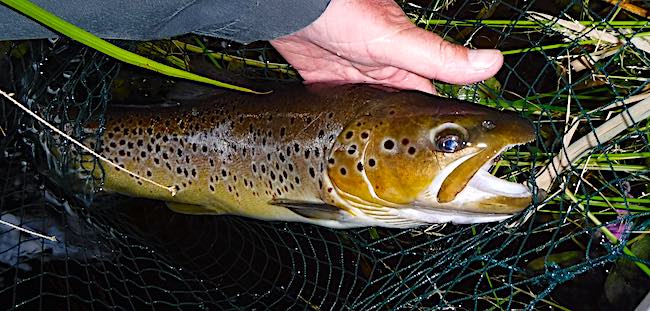
Fly fishing using streamers, in my opinion, is another tool in your arsenal that may help you avoid a blank day when other techniques fail to catch trout.
So, knowing…
how to fish streamers on rivers is worth having in your back pocket.
I’ve caught some beautiful brown trout streamer fly fishing on flooded rivers, which were unfishable using traditional fly fishing techniques.
Maybe, it will help you catch a specimen brown trout.
What fishing tackle is needed for fly fishing with streamers?
Best fly rod for streamer fishing
My fly rod preference for streamer fishing is a medium-tip action 10 ft 7 weight. However, a rod ranging from 9 to 10 ft and 6 to 7 weight would suffice. The rod must be strong enough to cast a huge streamer fly.
I started by using an inexpensive Shakespeare SIGMA Supra 10′ 7# rod for streamer fly fishing but now I use a 10ft 7# Greys GR80 fly rod.
Fly reels streamer fishing
Reel choice is not critical. However, it needs a sensitive drag system and holds a decent amount of backing.
I use an Airflo V2 large Arbor reel to cope with large brown trout; when the…

line is screaming off the spool…
you’ll be thankful for that extra backing capacity.
Fly line choice:
I use a weight-forward profile fly line for streamer fishing because it helps punch out large bushy flies. A standard reservoir fly fishing line will be fine (i.e. Airflo 40 plus )
The selection of fly line sinking rate depends on river conditions and the depth of the pool you are fishing.
Use a sinking rate that gets the fly quickly into the feeding zone without constantly snagging the riverbed.
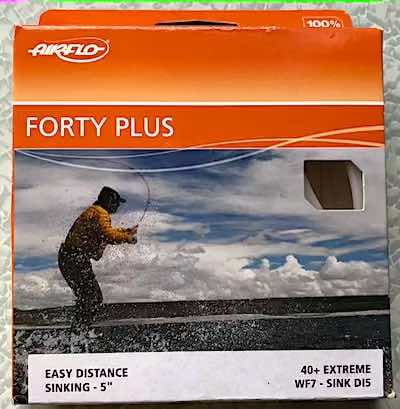
For fishing flooded rivers, I typically use Di5 to get the flies close to the riverbed quickly and sometimes a Di8 for deep (>10ft) flooded pools. However, a floating line tipped with a 5 to 7ft sinking polyleader will suffice when the river is at its summer level.
Leaders and tippets for streamer fly fishing
Trout will often hit streamers hard.
Therefore, use at least a 7 lb fluorocarbon tippet during the day and scale up to 10 lbs when fishing at night. I use Airflo Sightfree G3 tippet, but many other options are available.
You wouldn’t want to lose a specimen brown trout due to line breakage
To the end of the sinking line or polyleader, I add a 3-4ft length of tippet. That allows you to change the streamer a few times while keeping it in the desired fishing zone based on the line selected.
Streamer fly patterns
Streamer fly patterns imitate small fish that large trout eat, e.g. fry, minnows, or baitfish. Fly patterns vary in size from small Wooly Buggers (ca. 2 cm long) to complex articulated flies (ca. 10 cm long), but I rarely fish anything longer than 5 cm.
On the Welsh Dee and River Eden, I have caught plenty of brown trout when the river is in flood on the following selection of streamer flies:
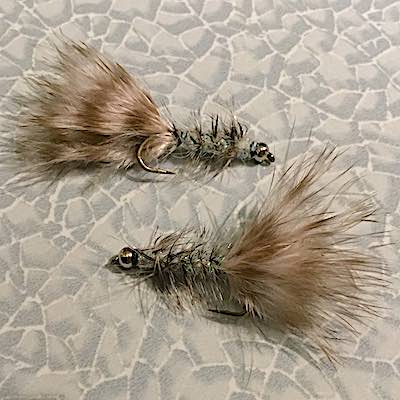
Grey Wooly Bugger
- Kamasan B800 (#10) – debarbed
- 3mm silvered tungsten bead
- Grey UNI-thread 6/0
- Tail – Grey/brown barred Marabou
- Body – Pearl Glister dubbing
- Hackle – palmered badger cock
- Rib – fine silver wire
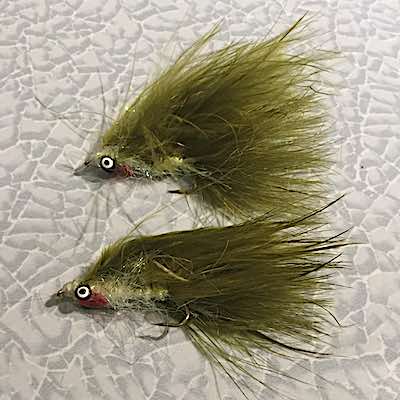
Olive Poodle
- Kamasan B800 (#10) – debarbed
- Eyes small tungsten dumbells
- Grey UNI-thread 6/0
- Tail – Marabou (olive or black)
- Body – Pearl Glister dubbing
- Wing – Marabou (olive or black)
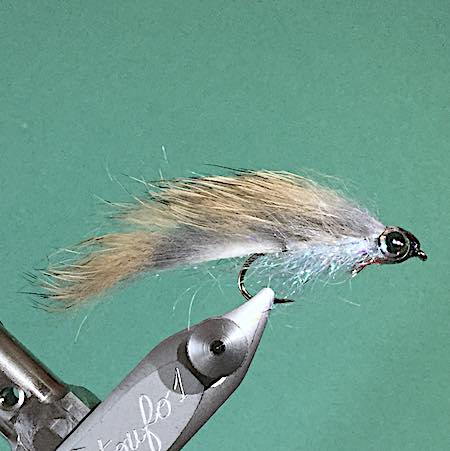
Grayling fry pattern
- Hook – Kamasan KB800 #10
- Black 8/0 UNI-thread
- Body – Pearl glister dubbing
- Wing – grey zonker strip
- 4mm Epoxy eyes
Techniques for fly fishing with streamers for trout
At the beginning and end of the trout season, rivers are often flooded and unfishable using traditional fly fishing techniques. Therefore, about ten years ago, I began streamer fishing for trout so that I could go fishing irrespective of the river condition.
Streamer fishing when the river is in flood & coloured
Faced with a flooded river, I seek out pools that have areas of slower-flowing water and back eddies where small fish are likely to shelter.
In deep pools, trout often lie where they are waiting to ambush prey:
- close to the riverbed in depressions,
- behind submerged obstacles (e.g. boulders, weed beds, etc),
- close to the bank.
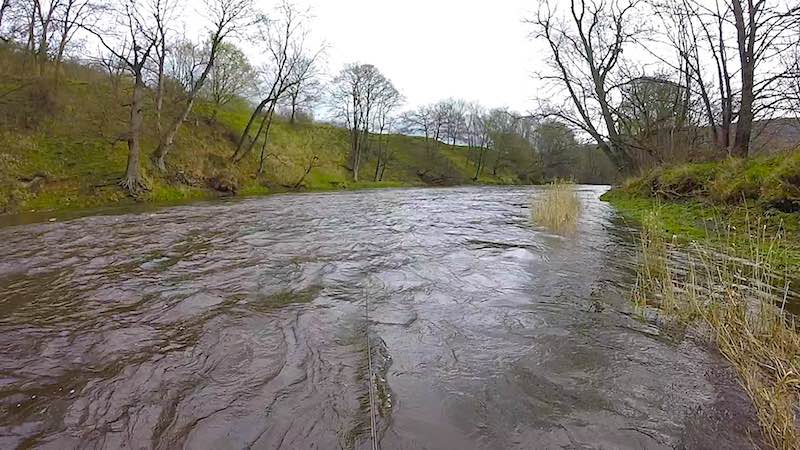
Examples of pools for streamer fishing on the Welsh Dee at Llangollen when the river is in flood (>0.9m Manley Hall gauge) include:
(Note, the links give an idea of what types of pools to look for on the river you plan to go streamer fly fishing.)
I use a 10ft 7wt rod with a fast-sinking Di5 line on flooded rivers. However, I scale up to a Di8 line for trout lying in deep pools (ca. 10+ ft deep). Attached to the end of the fly line is a 4 ft length of 10lb fluorocarbon (Airflo Sightfree G3).
In coloured high water, use a large streamer pattern, up to the maximum size permitted in the rules, on the beat you are fishing.
An effective technique is to start by casting a short line upstream at a 30-degree angle and allow the line to swing around in an arc while making short strips.
Then, when the fly is close to the near bank, make a couple of additional short strips to fish the near bank before recasting.
On each successive cast, extend the line by 1 m until the fly lands close to the far bank.
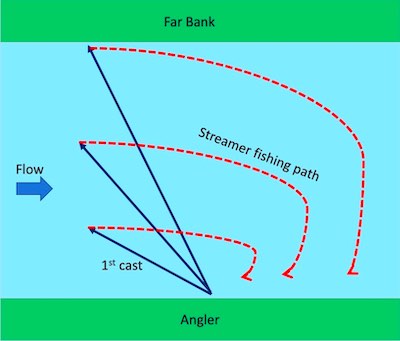
This procedure effectively fishes the river in front of you before moving downriver a few meters to repeat the process until you reach the end of the pool.
Streamer fishing when the river is running clear & near its summer level.
When the water is clear, I only go trout fly fishing with streamers if traditional fly fishing techniques have failed.
In this situation, I fish streamers using either a sink-tip line or a floating line tipped with a sinking polyleader and 5ft of 7lb fluorocarbon. The latter approach is my preference because it’s easy to change the sinking rate of the polyleader to fish pools of different depths.
To mitigate being smashed by big brown trout at dusk, switch to fishing a 10lb fluorocarbon tippet.
Early in the season, when fly life is less prolific, hungry brown trout will often aggressively take the big streamers as they compete for scarce food supplies. In summer, however, I tend to use smaller streamer fly patterns.
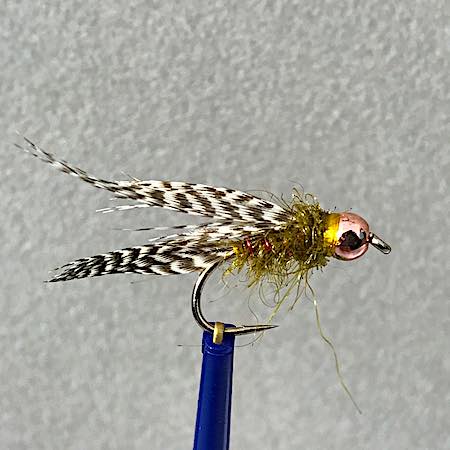
Teal Fry Pattern
- Kamasan B170 (#12 & 10) – debarbed
- 3mm copper tungsten bead
- Olive UNI-thread 8/0
- Tail – Teal flank fibres
- Body – Olive dubbing
- Rib – fine copper wire
- Wing – Teal flank fibres
My technique for fishing streamers for trout in clear water is to cast the fly upriver into any likely deep water lie, hold the rod high to allow the fly to sink, then add a downstream mend in the line, lower the rod, and strip the fly back through the pool.
Repeating that process by varying the casting angle and speed of retrieve while fishing through the pool.
Streamer and nymph fly fishing method
Another approach to fishing streamers through deep pools is fishing a small heavy streamer pattern on the point of a French Leader set-up and a small nymph on a dropper about 18 inches above the streamer on a 6lbs fluorocarbon tippet.
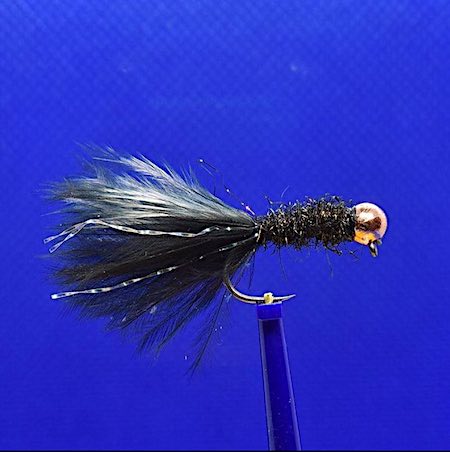
Black Jig-streamer
- #12 to 8 HENDS BL154
- 4mm copper tungsten bead
- Black UNI-thread 8/0
- Tail – Black Marabou + crystal flash
- Body – Black glister dubbing
Begin at the pool tail and fish upriver using streamers tied on jig hooks, which minimise fouling on the riverbed.
Cast the flies upriver, allow them to sink to the riverbed and guide the streamer downriver slightly faster than the current; that imitates a small fish chasing the nymph…
You are trying to induce that competitive instinct of trout!
Ensure you have a loop of line off the reel because takes with this approach can be savage. After setting the hook, let the trout take some line until you know its size.
I’ve found that upside-down streamers or streamers tied on jig hooks are the best flies for high water conditions.
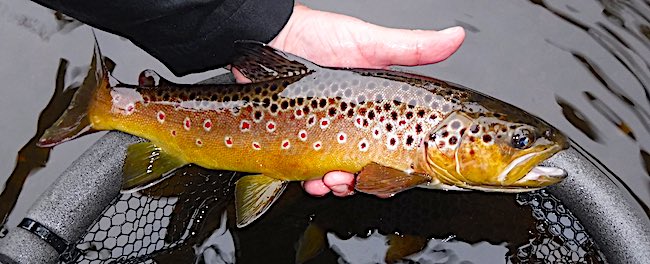
Streamer fishing at dusk & dawn in shallow water
Trout become less cautious when it becomes dark and move into shallower water to feed on small fish and fry, especially in the summer months. Therefore, this is a great time to spend fly fishing with streamers for trout.
When the light begins to fail on the Welsh Dee, I’ve caught some lovely brown trout fishing streamers in the long shallow glides and pool tails, which earlier in the day seemed devoid of trout.
In the evening, I fish large streamer fly patterns on a floating line tipped with a 5ft floating or intermediate polyleader and a 3ft tippet of 10lb fluorocarbon.
Typically, I cast the flies directly across to the far bank and allow them to swing around in the current to the dangle with a very slow retrieve. If that doesn’t work, try experimenting with different casting angles and speeds of retrieve.
Make a line strike if you feel a touch on the fly and hang on.
On the Welsh Dee during the summer months, you stand a good chance of hooking a sea trout and occasionally a large grayling on a streamer.
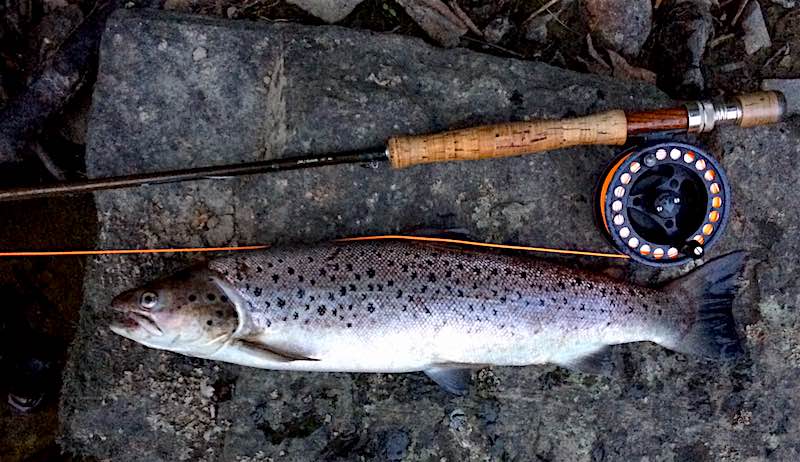
If you are interested in fly fishing with streamers for trout, there are some excellent day ticket beats on the Welsh Dee.
Final thoughts
It’s exciting streamer fishing for brown trout on the Welsh Dee. I love those aggressive takes and the sound of the…
Reel singing as a Big Trout tears off downriver.
I hope this article has inspired you to have a go at fly fishing with streamers. It’s definitely worth a go because you’re likely to hook a trophy brown trout.

Great article. Very interesting and informative. Hoping to give this a bash myself this season. I’ll be using my 8wt for now to see how it goes. Great to get an idea of what flies to tie up and how to fish them.
Cheers
John
Hi John,
Great to hear you enjoyed the article. It would be good to hear how you get on streamer fishing.
Cheers, Andrew
Great article ,very informative going to give it a go .
Let me know how you get on.
Cheers, Andrew
Exciting way of fishing Andrew , good way of getting into tight areas under trees , undercut banks etc . Putting an upstream mend in the line while stripping can really get the fly steaming across the swim and that’s irresistible to hungry trout isn’t it and the takes like your spinning with a Flying ‘c’ on , love it
Hi James,
Thanks for the comments and feedback. Glad you enjoyed the post.
Cheers, Andrew
Great article Andrew very informative good bit of reading in times when we can’t get out fishing looking forward to putting what I’ve read in all your reports on the Welsh Dee to practice soon
Hi Ian,
Fingers crossed, it looks like you will be able to practice some of this soon.
It’s great to hear you enjoyed the article.
Thanks for the feedback, Andrew
Not a method I’m familiar with Andrew, however when the river was high one day on a trip to NZ I tried it and I was pleasantly surprised how well it worked when all else failed! I’ve never tried it here at home in NI but after reading your article with all the great tips and advice I intend to when the need arises! Really busting to visit the welsh Dee when this pandemic
is hopefully under control! We had to cancel our trip last year……..
Really enjoy all your articles. Keep up the good work.
Cheers, Jimmy
Hi James,
Great to hear you are enjoying the articles and hopefully, you will be able to get out fishing on the Welsh Dee soon.
I only fish streamers on the Welsh Dee when the river is in flood but they will work at lower river levels especially during the summer when the fish are sulking at the bottom of deep pools and won’t take anything else.
Cheers, Andrew
thanks andrew. good post if i can ever get back on the dee i will give it a go
regards jim w.
Hi Jim,
Looks like we can fish the Welsh Dee from the 12th of April. Just in time for the weather to start warming up.
Cheers, Andrew
Hi Andrew very good and informative article
thanks for that worth a go
Definitely worth a go when the river is running off after a spate.
Good article with very useful information. Thanks! Tight Lines.
Hi Bryan,
Thanks for the feedback on the article. I hope it helps you catch a few nice brown trout.
Cheers, Andrew
Hi Andrew
Great timing with this article. I recently bought a job-lot of flies (I don’t tie my own). In the box were a number of streamers. This article has given me a good insight into how to fish them. Nice to know there is an option on a flooded river too. On The Manley Hall guage what reading signals that the river is too high for streamer fishing?
Hi John,
Great to hear that the article was very timely for you.
Your question about what river height is too high for streamers is not straight forward to answer because it depends on where you are fishing on the Welsh Dee. If you are fishing at Llangollen there are a couple of places you can fish when the river is at 1.3m Manley Hall gauge. However, I would say that at above 0.9m Manley Hall is the limit.
If you let me know where you are likely to be fishing I will try and give you a bit more advice.
I hope this helps, Andrew
Great article very interesting
Hi Andrew ….absolute belter of a blog …..you remind me of the late John Roberts,
I live in Rhosymedre so only 10 to 20 minutes down the road …..I don’t fish so much these days and packed in tying about 3 years ago some sight issues , but you really are stimulating some creative juices ….tight lines …..all the best for the future
Hi Jim,
It great to hear you enjoyed this blog.
Thanks for the great feedback.
Andrew
I am going to Llangollen this week for my first bash at river fishing. I have been looking for tips for coloured rivers in flood as the levels are high at the moment. This article is just what I needed. I will let you know how I get on. Thanks for taking the time to produce this blog. I love it.
Hi Mark,
I hope the tips help you catch some good trout when the river is in flood.
Cheers, Andrew
Very useful when you turn up on the river and find it apparently unfishable. Far better to wet a line with a proven method than sit on the bank miserable!
Keep ’em coming Andrew!
Hi Charles,
The method produces some good fish. Thanks for the comments, Andrew
Good read and interesting the trout chase smaller fish, oddly enough I was watch some trout on my local beck chasing small what looked like minnows or possibly stickle backs albeit not many fish like the spikes on a stickleback. It’s defiantly something I will try later this month when I’m next on my Beck in N York’s
You won’t be disappointed with the results. Let me know how you get on. Cheers, Andrew
I’ve used this method on the Derbyshire Wye and Dove. You are correct in that the fish are savage when they go for the fly, and the other thing is that fish can be in very shallow water on occasions (as long as you haven’t disturbed them of cse!).
Thanks for your useful comments. Chreweers, And
Hi Andrew tried the streamer approach today but failed to land anytime.think I need to sort the lines and tippets out.very enjoyable reading thankyou
Hi Andy,
Great to hear the post helped you try out this method. I find it works best when the river is dropping and clearing after a spate. When the river is clear, try it at the start of the day and in the evening.
Tight lines, Andrew
Hi Andrew,
I find your articles extremely informative and interesting, as I do this one.
Tight lines
Thank you Andrew, really good article that you made! Streamers are deadly for sewin (sea trout) and of course salmon in our lovely Weksh Dee!!
Hi Erwan,
Great to hear you enjoyed it and thanks for the comments.
Tight lines, Andrew